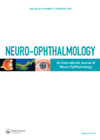Comparison of treatment for hemianopia following stroke
1 August 2016
| Claire Howard
|
EYE - Neuro-ophthalmology
|
Fresnel prisms, homonymous hemianopia, randomised controlled trial, recruitment, screening, stroke, visual search
The authors report the screening process and recruitment figures for a randomised controlled trial comparing interventions for post stroke homonymous hemianopia. Interventions included Fresnel prisms, visual search training and standard care (information only). Primary outcome measure was the change in...






